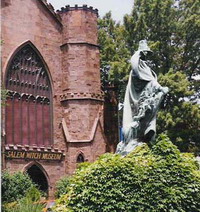Login form
Salem Witch Trials

In early 1692, a group of girls in the town of Salem, Massachusetts, started to have mysterious fits. Their bodies twitched and they shrieked with pain. People at that time believed that the Devil used witchcraft as part of his evil work. Worried parents feared their daughters had been bewitched. To cure the girls, the town had to find and punish the witches. Adults pressured the girls to tell them who the “witches” were, launching a witch hunt in Salem. By October 1692, 20 people had been named, put on trial, and killed for being witches.
WHO WAS ACCUSED OF WITCHCRAFT?
People believed the Devil tempted a woman into evil more easily than a man. Most of the people accused in Salem were women. At first the girls only accused a few women. But the finger-pointing spread until over 100 men and women had been charged with practicing witchcraft.
HAT WERE THE TRIALS LIKE?
The town put the accused “witches” in jail to wait for trial. Once in court, judges fired questions at the accused, such as: Do you have contact with the Devil? Why do you hurt these children? The girls who made the accusations sat in court, sometimes wailing that they saw the Devil whispering in the ear of the “witches.”
The people who were accused hotly denied that they were witches. They had never spoken with the Devil or hurt any children! They were innocent! But their protests did not help. Nineteen people were hanged. One man was pressed to death with large rocks.
HOW DID THE TRIALS END?
As the number of arrests rose, many Salem citizens grew alarmed. Because no proof was needed, people could simply accuse a person they didn’t like of being a witch. Many raised their voices against the witch hunts. In October 1692, the governor of Massachusetts ordered the trials stopped. The courts freed people still waiting for trial. Within a few years, some people in Salem expressed regret for the role they’d played in executing innocent people.
Source: Microsoft ® Encarta

